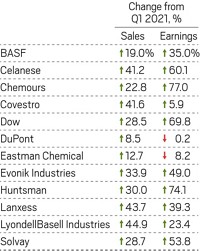Advertisement
Grab your lab coat. Let's get started
Welcome!
Welcome!
Create an account below to get 6 C&EN articles per month, receive newsletters and more - all free.
It seems this is your first time logging in online. Please enter the following information to continue.
As an ACS member you automatically get access to this site. All we need is few more details to create your reading experience.
Not you? Sign in with a different account.
Not you? Sign in with a different account.
ERROR 1
ERROR 1
ERROR 2
ERROR 2
ERROR 2
ERROR 2
ERROR 2
Password and Confirm password must match.
If you have an ACS member number, please enter it here so we can link this account to your membership. (optional)
ERROR 2
ACS values your privacy. By submitting your information, you are gaining access to C&EN and subscribing to our weekly newsletter. We use the information you provide to make your reading experience better, and we will never sell your data to third party members.
Business
Inorganics: Caustic Soda, Soda Ash Producers Hope For A Calmer 2010
by Michael McCoy
January 11, 2010
| A version of this story appeared in
Volume 88, Issue 2

Like most chemical makers, companies that manufacture inorganics look forward to a better year in 2010. But for producers of caustic soda and soda ash—two of the sector’s staple commodities—a smoother ride is on the wish list as well.
COVER STORY
Inorganics: Caustic Soda, Soda Ash Producers Hope For A Calmer 2010
Caustic soda, the chemical industry’s workhorse alkali, has always traveled a bumpy road because it is coproduced with chlorine via the electrolytic separation of sodium chloride. Because chlorine is a gas and not easily stored, it drives chlor-alkali production. Caustic soda must make the best of the ride.
As 2009 began, poor demand for polyvinyl chloride, a plastic used extensively in construction, kept U.S. chlorine demand low and constrained output of caustic soda, recalls B. Chuck Anderson, president of Occidental Chemical, the world’s largest merchant marketer of chlorine. Chlorine sales may have been way off, but OxyChem and its competitors were getting upward of $1,000 per ton for caustic soda.
Then destocking started. Seeking to hold on to cash, customers stopped buying caustic, letting their inventories run down instead. “People were desperate to move product, and that caused a freefall in prices,” Anderson says. By June 1, caustic soda was selling for just $60 per ton on the spot market.
Business bottomed out at midyear, Anderson says, and chlorine demand perked up some in the second half, thanks to healthy exports of PVC, which benefited from low raw material prices. He sees the trend continuing and chlorine demand rising as much as 10% in 2010.
U.S. soda ash producers endured their own whipsaws last year as they faced down new Chinese competitors in the export market. Michael Wilson, general manager of FMC’s industrial chemical business, the number one U.S. soda ash maker, says demand weakened significantly in the first half of 2009. But in the second half, the U.S. industry used its favorable cost position to gain export market share, particularly in Asia.
Wilson anticipates a modest recovery in soda ash demand across the globe this year. Even better, he expects that the U.S. industry will run at nearly 100% of its capacity in 2010.
FMC’s other big inorganic, hydrogen peroxide, suffered last year, Wilson says, with North American demand falling as much as 25%. He expects an improvement of only 3 to 4% in 2010. Specialty peroxygens, such as persulfates and peracetic acid, weathered 2009 much better, he adds, and the outlook for 2010 is good, thanks to robust environmental and food safety markets.




Join the conversation
Contact the reporter
Submit a Letter to the Editor for publication
Engage with us on Twitter